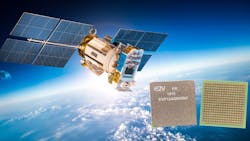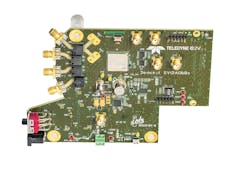Four-Channel ADC Makes the Grade for Space
The industry’s first four-channel analog-to-digital converter (ADC) qualified for space applications has been confirmed by Teledyne e2v. The company’s model EV12AQ600 ADC is a radiation-hardened device that can withstand a total ionizing dose (TID) of 150 kRad and provides the exceptional reliability needed to survive long-term missions in satellites and other space vehicles. It meets NASA and ESA requirements according to MIL-PRF-38535 (ML-Y) and ESCC 9000 standards.
The model EV12AQ600 ADC (see the figure) features 12-bit resolution and 1.6 GS/s maximum sampling rate across each channel or a maximum rate of 6.4 GS/s for one channel when the four channels are interleaved. The space-qualified ADC can be programmed remotely, such as when the device is in orbit, thanks to a cross-point switch following the input ports and an accompanying Xilinx model XQRKU060 field-programmable gate array (FPGA). Programming of such parameters as the number of channels, the bit rate, and the dynamic range can be changed while the FPGA is in space. In addition, a collection of FPGA libraries is available to support different applications using the FPGA ecosystem.
“Through our space-qualified EV12AQ600 devices, we are able to offer customers high-performance data converter solutions that are ready to integrate directly into their systems,” explains Nicolas Chantier, marketing director at Teledyne e2v. He adds: “It means that they can benefit from flight-proven TRL9 technology, without the need for any further qualification effort. Also, with inventory now available, there are much shorter lead times associated with these ADCs than competing solutions currently on the market. Customers can therefore get access to samples straight away.” Measurement data related to the space qualification of the four-channel ADC, including extensive shock, vibration, and electrostatic-discharge (ESD) testing, can be found at the company's website.
The prototype PCBs also include a high-speed internal reference clock for 6.4-GHz operation, a +12-V DC power supply, and an ESIstream serial interface. The prototyping circuit boards can also be connected to an external reference clock and temperature monitor for experimentation. The new development kits provide additional options to earlier kits based on the company’s EV12AQ60x series of ADCs, with prototype boards containing field-programmable gate arrays (FPGAs). The ADCs incorporate a cross-point switch that allows the EV12AQ600 and EV12AQ605 ADCs to sample at rates to 1.6 GS/s in four-channel mode, to 3.2 GS/s in two-channel mode, and to 6.4 GS/s when using a single channel.
About the Author
Jack Browne
Technical Contributor
Jack Browne, Technical Contributor, has worked in technical publishing for over 30 years. He managed the content and production of three technical journals while at the American Institute of Physics, including Medical Physics and the Journal of Vacuum Science & Technology. He has been a Publisher and Editor for Penton Media, started the firm’s Wireless Symposium & Exhibition trade show in 1993, and currently serves as Technical Contributor for that company's Microwaves & RF magazine. Browne, who holds a BS in Mathematics from City College of New York and BA degrees in English and Philosophy from Fordham University, is a member of the IEEE.

